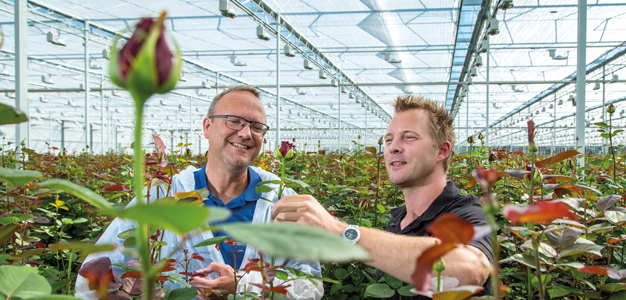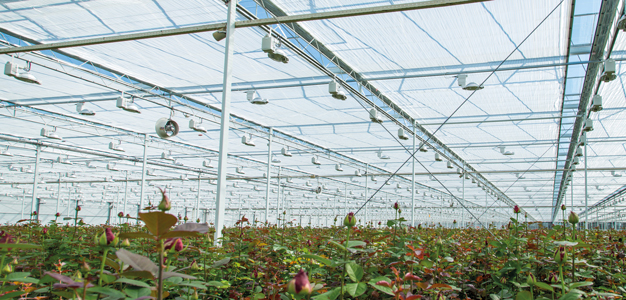New Harmony for Lansbergen Roses
The moment finally came in May when the Lansbergen Roses greenhouses were to be equipped with the modern New Harmony screen. “If everything is right, it will result in the best possible growth”

It was time for rose cultivator Peter Lansbergen from Moerkappele to replace his climate screen, as the old aluminium screen was no longer up to the task. The moment was finally came in May for the Lansbergen Roses greenhouses to be equipped with the modern New Harmony screen made by Svensson. “I want over 20 moles in the greenhouse throughout the year. And now I achieve these PAR-values straight away!”
Peter Lansbergen - son of a rose cultivator from Schipluiden - purchased a 2.5-acre greenhouse in Moerkappelle, Holland in 2006. “I was young, ambitious, and saw the big companies around me grow." He decided to optimise his business step by step. “The cultivation of roses is intensive. You can only make money if everything is right. It is important to stay sharp and continuously work on optimising labour, quality, marketing and your own knowledge, among other factors.”
Lansbergen replaced the entire lightning system at his company a few years ago and installed additional lighting in 2015. For 2016, he wanted a new climate screen. The aluminium screen in the greenhouse was already 10 years old. “Each year 1 to 2% more dirt accumulates. My old screen only let in about 50% of the light. He asked his installer for a new Svensson screen. I was in doubt: should I just replace the climate screen, or should I also replace the light emission screen? I chose to do both. It is one fell swoop and you only suffer the installation noise once. Since both screens are on the same wire bed, replacing everything in its entirety is the best thing to do. Rather than shopping around, I opted for Svensson straight away. Svensson does not simply sell screens, they also focus on research, knowledge and advice.”
Sometimes, it was too dark
A few months ago, in May, the New Harmony screen was installed, along with the light emission screen. “I took the decision in December but the first possible moment to install the screen was around Valentines Day - after the frost period - but you do not want any installers in your crop during that time. You are also required to limit you light emission during the intensive lightning period in the winter, which made removing the screen impossible. Waiting for summer would have been too late, since that's when you really need to use the screens. This is why we decided the installation would take place in May. I informed the municipality that my ability to stop light emissions would be hampered for a week, but that I had an economic necessity to keep the lights on. They gave me permission for to proceed.” After consulting with crop adviser Edwin van der Knaap of Delphy BV, Lansbergen selected Harmony 2315 O FR, a New Harmony screen with 23% shade protection (the screen is available in percentages up to 80%, in 10% increments). This percentage was a substantial improvement compared to 50% in the classic screen version.
“When I closed the old screen, it was too dark. But in spring and autumn, you want to adjust your degree of protection in small steps.” Svensson launched New Harmony last winter at HortiContact (De Tuinbouw Relatiedagen) in Gorinchem. It’s an improved version of the classic Harmony. Paul Arkesteijn, product manager and climate specialist at Svensson: “Aluminium screens have long been the standard in horticulture. Harmony was launched around eight years ago: it was the first screen that provided diffuse light. It was a revolution. New Harmony has perfected the classic Harmony.”

Better light
The degree of protection was not what tipped the scales for Lansbergen. The most important characteristic of New Harmony is the extent to which the screen provides diffused light. Lansbergen: What does a rose consist of?” It is primarily a plant with shoots and buds. These must receive light, but the bud should not be burned. Thanks to my new screen, the shoots receive more light, and my buds are not at risk of being damaged by any direct sunlight. This has improved the quality of the buds. The light in the greenhouse is better distributed over the crop, which results in better outgrowths and better protection of the rose buds. This makes a cultivator happy.” Arkesteijn: “Diffuse light has two advantages: first there is more photosynthesis, as the light hits more spots, and secondly, you can let more light into your greenhouse because the light is diffused. Both factors contribute to more growth.”
Achieving the PAR-values
“I want 20 moles in my greenhouse throughout the year", says Lansbergen. “This means intensive lighting in the winter, since there isn’t enough light outside. But we use fewer lights in the summer, and I want to be able to make the best possible use of natural light. My old screen blocked too much light, but not using a screen wasn't possible either. I needed to use lighting at night to reach the necessary PAR-values. With my new screen, it is easier to reach these PAR-values with the use of daylight. Lansbergen also paints his greenhouse using a diffuse chalk agent. Arkesteijn: “Harmony improves the diffuse quality of the light and provides high-quality diffuse light in the greenhouse.
The light diffusion, also known as 3D-scatter, is unparalleled when using New Harmony.” Lansbergen: “My new screen allows me to postpone painting, and I’m able remove it earlier in the year. I used to apply chalk early in the spring when the sun can be very bright, since there is less moisture in the air. By painting, I was able to keep my crops from getting burned by the sun. However, the sun is usually only this bright for a couple of hours per day. Thanks to the new screen, I don't have to use chalk for such conditions.

Homogeneous growth
The New Harmony has more advantages. Not only is the vertical distribution of the light perfect, the horizon distribution has also improved significantly. There are fewer shadows caused by trusses or fixtures. Arkesteijn: “New Harmony grants plants in the shade 32% more light than the classic Harmony did. The crop receives the same amount of light - both per moment and cumulatively. This results in homogeneous growth.” With the new light emission screen (Obscura 9950 FR W), Lansbergen Roses also complies with the light emission rules. “My insurance provider will also be happy. I had my installation inspected in December - this was mandatory if you didn't install a fire-retardant screen before 2017.” Lansbergen: “I am happy with my crops, and not just because of the screen. I have been dosing more CO2 and it was a good summer for the roses. We have been using more light in the winter by expanding the number of fixtures. But it all adds up. When all conditions are correct, it will result in the best possible growth.”
The best performance
“The screen defines the crop", says product manager Paul Arkesteijn of Svensson. This is why Svensson has recently become more active in advising growers. “We have an advice team for growers: In a personal consultation, we explain what screen would be best for them. This is based on the results of our studies in the greenhouse climate underneath the screens.”